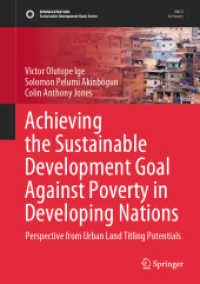- ホーム
- > 洋書
- > ドイツ書
- > Mathematics, Sciences & Technology
- > Medicine & Pharmacy
- > internal medicine and surgery
基本説明
The second clinical manual, following their bestseller The SAGES Manual: Fundamentals of Laparoscopy and GI Endoscopy.
Full Description
The second SAGES (Society of American Gastrointestinal Endoscopic S- geons) manual was intended to be a companion piece for the successful ?rst SAGES manual, edited by Carol Scott-Connor, that was published more than 4 years ago. Originally, the goal was to concentrate on tersely covered or often ignored aspects of the preoperative preparation of the patient and the operating room as well as the postoperative care of patients undergoing minimally in- sive operations. It was also our intention to include a section for each procedure where several different port placement schemes would be presented and brie?y discussed. Unique to this manual, the impact of the patient's body habitus (short or long, narrow or wide) on port placement is also taken into account for many of the procedures. Also unique are chapters devoted to hypothermia, port wound closure, and the management of subcutaneous emphysema and abdominal wall hemorrhage caused by trocars. Naturally, the surgeon tends to focus on the technical aspects of the pro- dure, such as the operative tasks to be carried out, the order of operation, and the position of the surgeon and assistant. However, it is critical that the surgeon be aware that the CO pneumoperitoneum, far more so than laparotomy, results 2 in multiple physiologic alterations that, if not compensated for by the anest- siologist and surgeon, may endanger the patient or prevent the laparoscopic c- pletion of the procedure.
Contents
Perioperative Management and Evaluation.- Preoperative Evaluation of the Healthy Laparoscopic Patient.- Preoperative Evaluation of Complex Laparoscopic Patients.- Preoperative Patient Instructions.- Contraindications to Laparoscopy.- Perioperative Antibiotics in Laparoscopic Surgery.- Intraoperative Management, Positioning, Setup, and Port Placement.- IntroductoryRemarks Concerning Operating RoomSetup, Patient Positioning, and PortPlacement Chapters.- Intraoperative Management of the Laparoscopic Patient.- Summary of Intaoperative Physiologic Alterations Associated with Laparoscopic Surgery.- Patient Positioning and Logistics in the Operating Room During Laparoscopic Biliary Surgery.- Hepatobiliary, Cholecystectomy, and Common Bile Duct Exploration (CBDE). Includes Cholangiography and Intraoperative Choledochoscopy: Port Placement Arrangements.- Operating Room Setup and Patient Positioning for Laparoscopic Gastric Bypass and Laparoscopic Gastric Banding.- Minimally Invasive Procedures for Morbid Obesity: Port Placement Arrangements.- Patient Positioning and Operating Room Setup for Laparoscopic Treatment of Gastroesophageal Reflux Disease.- Port Placement Arrangements for Gastroesophageal Reflux Disease Surgery.- Minimally Invasive Esophageal Resection: Patient Position and Room Setup.- Port Placement for Minimally Invasive Esophagectomy.- Hernia Repair: Patient Positioning and Operating Room Setup.- Hernia Repair: Patient Positioning and Operating Room Setup.- Spinal Access Operating Room Setup and Patient Positioning.- Spinal Access Surgery Port Placement Arrangements.- Operating Room Setup and Patient Positioning for Laparoscopic Adrenalectomy and Donor Nephrectomy.- Port Placement in Laparoscopic Adrenalectomy and Donor Nephrectomy.- Colorectal Resections: Patient Positioning and Operating Room Setup.- Port Placement Arrangements: Laparoscopic-Assisted Colorectal Resections.- Port Placement Arrangements for Hand-Assisted Colorectal Resections.- Patient Positioning and Operating Room Setup: Splenectomy.- Splenectomy: Port Placement Arrangements.- Laparoscopic Ultrasonography: Patient Positioning and Operating Room Setup.- Laparoscopic Ultrasonography: Port Placement Arrangements.- Intraoperative Upper and Lower Endroscopy Considerations.- Choice of Laparoscopic Exposure Method.- Anchoring Laparoscopic Ports.- Trocar- and Port-Related Bleeding.- Prophylaxis Against Deep Venous Thrombosis.- Hypothermia.- Implications of Subcutaneous Emphysema and How to Avoid and/or Limit Its Development.- Fluid Management and Renal Function During a Laparoscopic Case Done Under CO2 Pneumoperitoneum.- Port Site Closure Methods and Hernia Prevention.- Postoperative Management of the Laparoscopic Patient.- Perioperative Fluid Management.- Ambulation and Early Postoperative Performance Criteria.- Pulmonary Considerations.- Resumption of Diet and Recovery of Bowel Function.- Wound Management and Complications.- Postoperative Restrictions After Laparoscopic Operations.- Pneumoperitoneum and Minimally Invasive Methods.- Cardiovascular Effects of CO2 Pneumoperitoneum.- Pulmonary Implications of CO2 Pneumoperitoneum in Minimally Invasive Surgery.- Renal Ramifications of CO2 Pneumoperitoneum.- The Systemic Oncologic Implications of Surgery.- Liver Function and Portal Blood Flow.- Port Site Tumors: Local Oncologic Effect.- Port Site Tumors: Means of Prevention.- Immunologic Consequences and Considerations of the Laparoscopic Approach.- Effect of Patient Position on Cardiovascular and Pulmonary Function.- Pros and Cons of Alternate Gases and Abdominal Wall Lifting Methods.- Risk of Gas Embolism with CO2 and Other Gases.- Impact of CO2 Pneumoperitoneum on Body Temperature and the Integrity of the Peritoneal Lining.- Adhesion Formation.- Impact of Minimally Invasive Methods on Postoperative Pain and Pulmonary Function.- Ergonomics in Laparoscopic Surgery.- Decision to Convert to Open Methods.







